TiktokSearches (Removal Instructions) - Chrome, Firefox, IE, Edge
TiktokSearches Removal Guide
What is TiktokSearches?
TiktokSearches is a browser hijacker that utilizes popular app's name to push ads

TiktokSearches is a potentially unwanted program[1] that users can discover on their Google Chrome, Mozilla Firefox, Safari, or another web browser unexpectedly, as it mainly spreads via software bundle packages and other deceptive methods. Once inside the system, it alters web browser settings and sets portal.tiktok-searches.com as homepage and new tab address. Besides, the PUP also appends a customized search engine that redirects all searches to Yahoo.
Deceitful infiltration methods are not the only suspicious activity that TiktokSearches engages with, however. As long as the extension or a standalone application is installed on a Windows or Mac computer, it will track users' web browser activities to feed them with various ads – it intercepts their searchers and inserts sponsored links into search results that are displayed at the top.
| Name | TiktokSearches |
| Type | Browser hijacker |
| Distribution | While some users might install a browser hijacker intentionally via its official website or trusted providers, most users find the app installed behind their backs – deceptive advertisements and software bundling are used as main distribution tactics by the developers |
| Symptoms |
|
| Risks | Installation of other potentially unwanted programs or even malware, privacy-related issues, financial losses |
| Removal | You can get rid of unwanted apps automatically by scanning your device with anti-malware or use manual guide we provide below |
| Further steps | After PUP or malware elimination, we recommend scanning the machine with FortectIntego to ensure its optimal operation. Additionally, if the ads and redirects do not stop, you can reset all the installed browsers |
Despite its name, TiktokSearches browser hijacker has nothing to do with a mega-popular TikTok video-sharing application (which received its own fair share of criticisms – app developers were accused of inappropriately gathering user information and inadequately protecting minors from inappropriate content).[2] The developer is simply using the name of the app's popularity in order to make the PUP more attractive to end-users.
Instead, TiktokSearches belongs to a larger group of rebranded browser hijackers that visually look almost identically. On the main page, the developers add seemingly useful features, such as converters for bitcoin/PDF/currency. While these can be put at good use, you should keep in mind that the app is a browser hijacker, and has plenty of negative sides that would warrant TiktokSearches removal.
TiktokSearches virus is one of many browser-hijacking apps that come from the same developer – others include:
As evident, all of these hijackers have a very distinct theme, although they all have just one goal – to deliver advertisements to users' browsers, regardless if they want them or not. First of all, most can spot the TiktokSearches hijack very quickly, as the app modifies the looks of their start page. Even if users try to search through the URL bar, they will still be rerouted via the predetermined patch, which will lead them to Yahoo or another search engine.
To ensure maximum profits from each of the users who has the PUP installed, developers fill the search results with sponsored links, although they have little to do with Yahoo, as it only serves as a search engine provider. Thus, each time you browse the web, you do not see organic results and instead are steered to sponsored sites.

Another reason to remove TiktokSearches is its data tracking practices. Just like any other hijacker, the app attempts to collect anonymous (browser type, device, language preferences, visited pages, ad clicks, search logs) and some personal (IP address and other unique identifiers) information. This data can also be shared with “other third parties,” as explained in the Privacy Policy:
Other third parties (including retailers, media networks, feed providers) in any of the above circumstances, as well as for the purpose of developing or delivering content (whether via our Service, or websites, applications or services of third parties), or for the purpose of improving our Service, conducting business analysis or other business purposes.
Thus, we recommend you get rid of the so-called TiktokSearches virus and use legitimate search tools instead. The process can differ depending on what type of app you have installed on your device. For example, TiktokSearches uninstall can be performed via the browser if it is established as an extension.
For further checks and improvements, you can also reset the installed web browsers and scan your machine with anti-malware, as well as repair tools such as FortectIntego.
You can easily prevent the installation of potentially unwanted software
Security experts[3] believe that generally, browser hijackers are not considered as a significant security threat. Nonetheless, due to suspicious infiltration techniques and unexpected web browser changes, some users refer to these unwanted apps as viruses. While not technically correct, this term is associated with computer activity users never asked for in the first place.
Browser hijackers are typically spread via a technique called software bundling and are usually used by third-party software distribution sites. Nonetheless, it is also infamously used by fake update prompts or torrent sites, both of which can be a high-security risk. Thus, while you should never download software from insecure sites, you should always keep your eyes wide open when you are performing the installation steps of a new application.

You should never rush the installation steps by skipping steps – this is one of the reasons you might have missed additional components that are included in a single installation package. Application developers and site authors often use various tricks to mislead users and make them install software they never wanted. Therefore, watch out for pre-ticked boxes, fine print, misleading offers, and similar ticks; always pick Advanced/Custom settings instead of Recommended ones when prompted – this will allow you to stay in control of the installation process from start to finish.
Uninstall TiktokSearches from your computer
As previously mentioned, TiktokSearches removal highly depends on what type of application you have installed on your PC. For example, the uninstallation of an extension should not cause you difficulties – all you have to do is access the add-on section via your web browser's settings. In case the app is grayed out and is impossible to delete, you can use our browser reset instructions below that could help you.
If you have a program installed on your computer, you can remove TiktokSearches manually via the Programs and Features (Windows) or Applications (Mac) folders, as explained in the instructions below. For further checks, we also highly recommend scanning the machine with a powerful anti-malware, as some threats that might be present on your computer might be running in the background without giving out any indications.
You may remove virus damage with a help of FortectIntego. SpyHunter 5Combo Cleaner and Malwarebytes are recommended to detect potentially unwanted programs and viruses with all their files and registry entries that are related to them.
Getting rid of TiktokSearches. Follow these steps
Uninstall from Windows
To uninstall TiktokSearches from Windows, perform the following actions:
Instructions for Windows 10/8 machines:
- Enter Control Panel into Windows search box and hit Enter or click on the search result.
- Under Programs, select Uninstall a program.
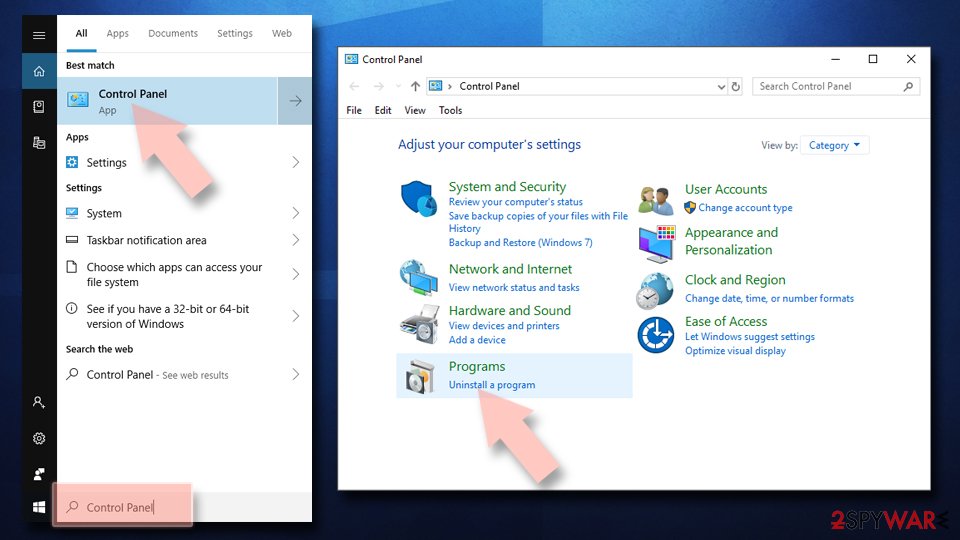
- From the list, find the entry of the suspicious program.
- Right-click on the application and select Uninstall.
- If User Account Control shows up, click Yes.
- Wait till uninstallation process is complete and click OK.
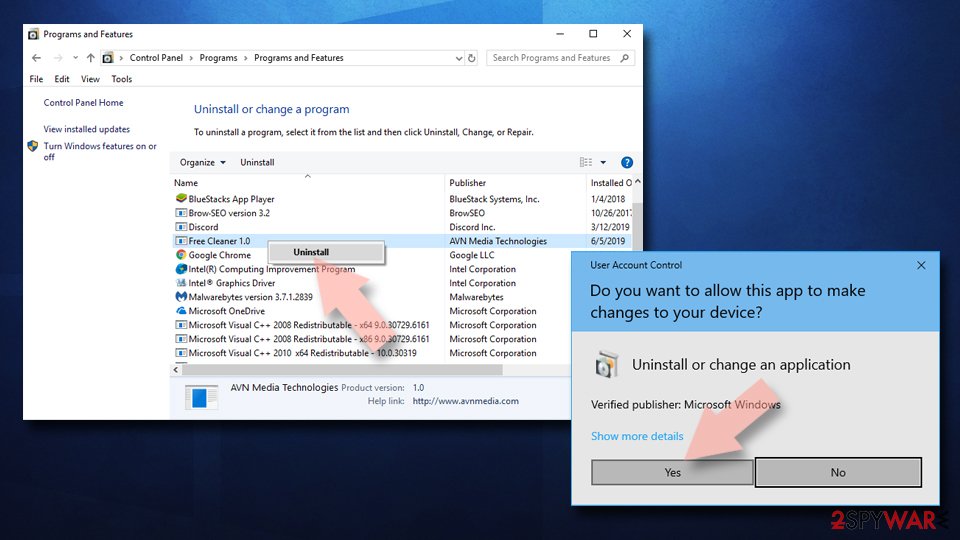
If you are Windows 7/XP user, proceed with the following instructions:
- Click on Windows Start > Control Panel located on the right pane (if you are Windows XP user, click on Add/Remove Programs).
- In Control Panel, select Programs > Uninstall a program.

- Pick the unwanted application by clicking on it once.
- At the top, click Uninstall/Change.
- In the confirmation prompt, pick Yes.
- Click OK once the removal process is finished.
Delete from macOS
macOS users can also get infected with a browser hijacker – follow these steps if you do:
Remove items from Applications folder:
- From the menu bar, select Go > Applications.
- In the Applications folder, look for all related entries.
- Click on the app and drag it to Trash (or right-click and pick Move to Trash)
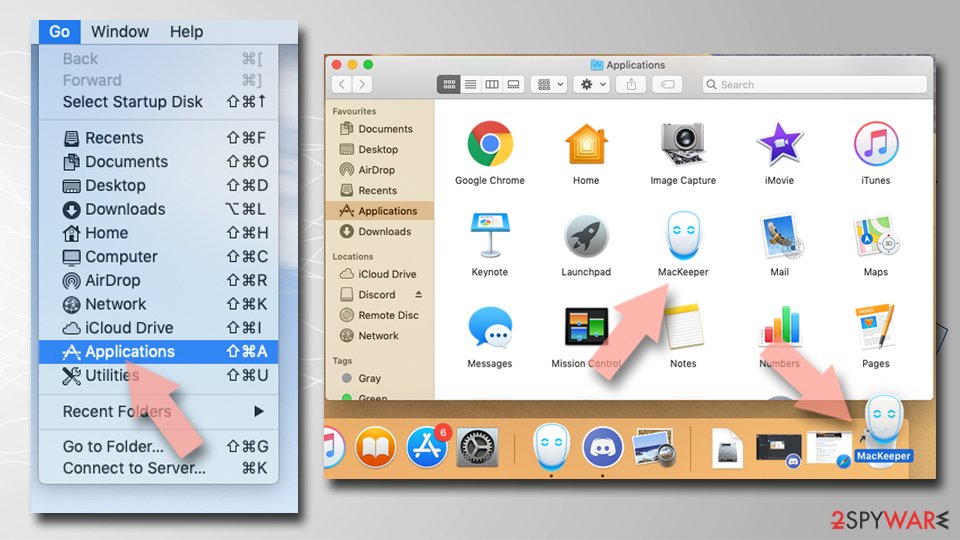
To fully remove an unwanted app, you need to access Application Support, LaunchAgents, and LaunchDaemons folders and delete relevant files:
- Select Go > Go to Folder.
- Enter /Library/Application Support and click Go or press Enter.
- In the Application Support folder, look for any dubious entries and then delete them.
- Now enter /Library/LaunchAgents and /Library/LaunchDaemons folders the same way and terminate all the related .plist files.

Remove from Microsoft Edge
Delete unwanted extensions from MS Edge:
- Select Menu (three horizontal dots at the top-right of the browser window) and pick Extensions.
- From the list, pick the extension and click on the Gear icon.
- Click on Uninstall at the bottom.
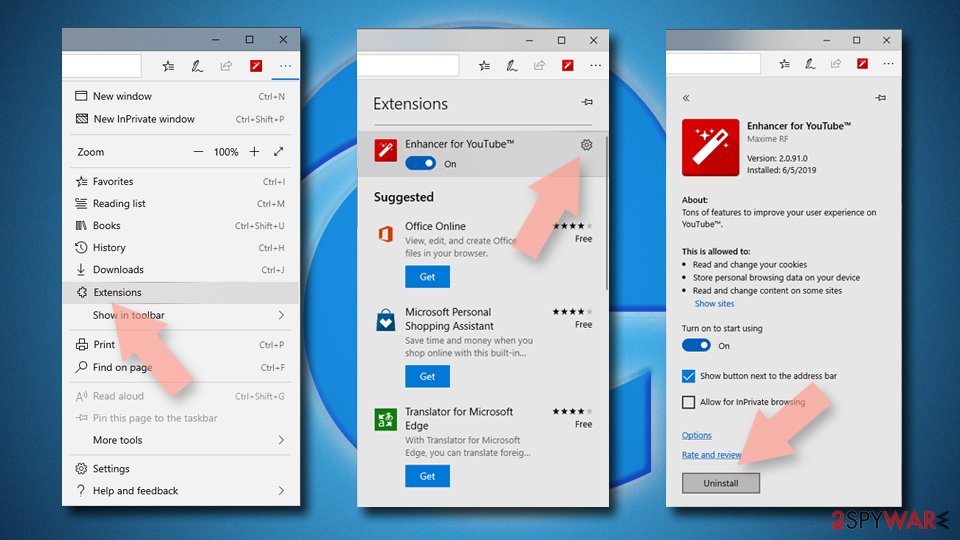
Clear cookies and other browser data:
- Click on the Menu (three horizontal dots at the top-right of the browser window) and select Privacy & security.
- Under Clear browsing data, pick Choose what to clear.
- Select everything (apart from passwords, although you might want to include Media licenses as well, if applicable) and click on Clear.
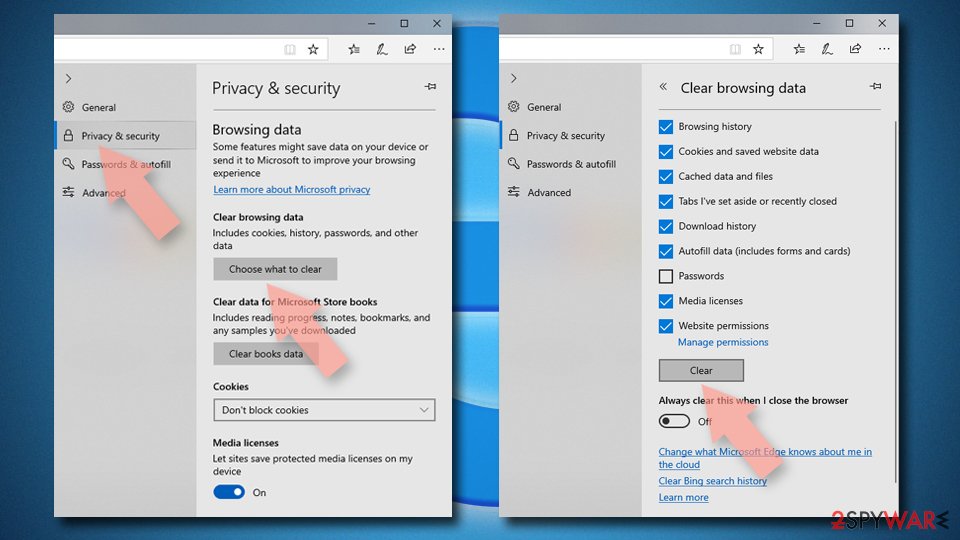
Restore new tab and homepage settings:
- Click the menu icon and choose Settings.
- Then find On startup section.
- Click Disable if you found any suspicious domain.
Reset MS Edge if the above steps did not work:
- Press on Ctrl + Shift + Esc to open Task Manager.
- Click on More details arrow at the bottom of the window.
- Select Details tab.
- Now scroll down and locate every entry with Microsoft Edge name in it. Right-click on each of them and select End Task to stop MS Edge from running.
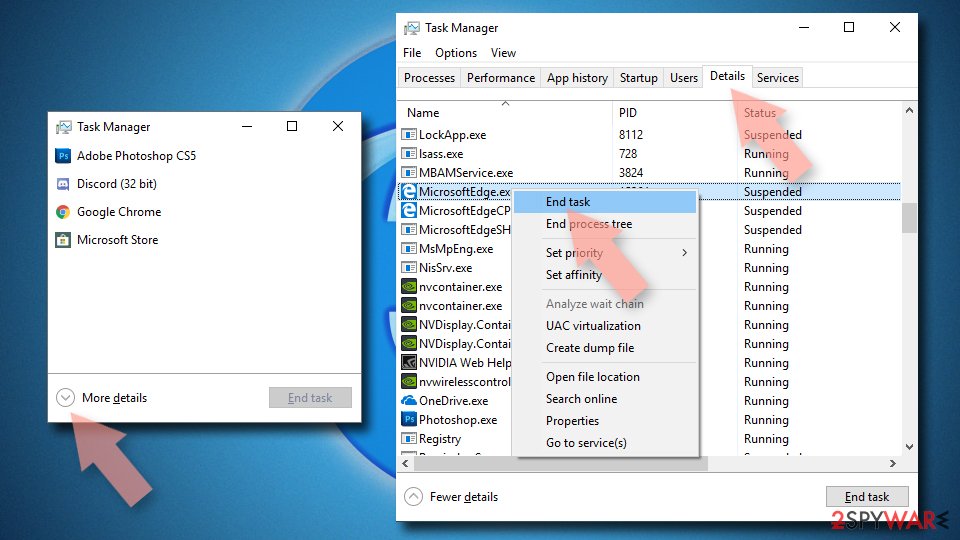
If this solution failed to help you, you need to use an advanced Edge reset method. Note that you need to backup your data before proceeding.
- Find the following folder on your computer: C:\\Users\\%username%\\AppData\\Local\\Packages\\Microsoft.MicrosoftEdge_8wekyb3d8bbwe.
- Press Ctrl + A on your keyboard to select all folders.
- Right-click on them and pick Delete
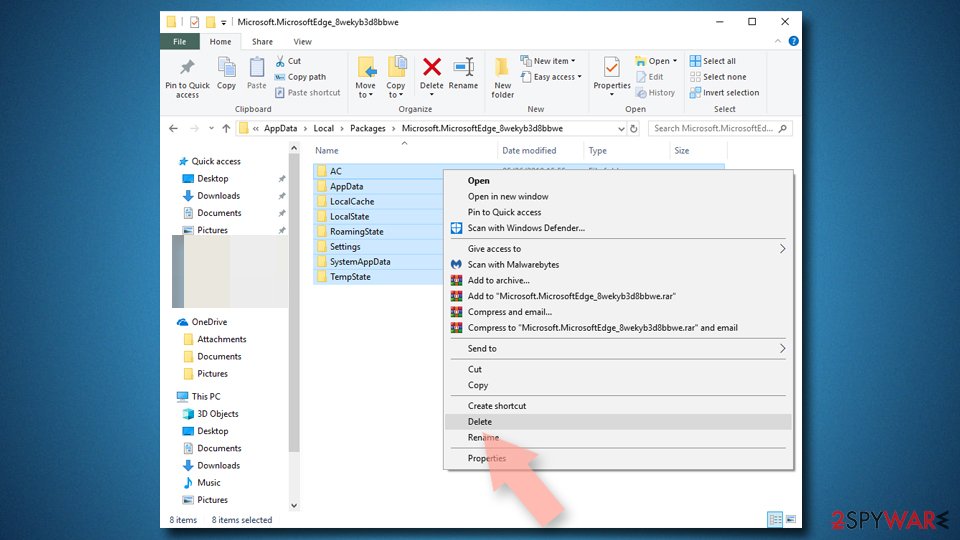
- Now right-click on the Start button and pick Windows PowerShell (Admin).
- When the new window opens, copy and paste the following command, and then press Enter:
Get-AppXPackage -AllUsers -Name Microsoft.MicrosoftEdge | Foreach {Add-AppxPackage -DisableDevelopmentMode -Register “$($_.InstallLocation)\\AppXManifest.xml” -Verbose
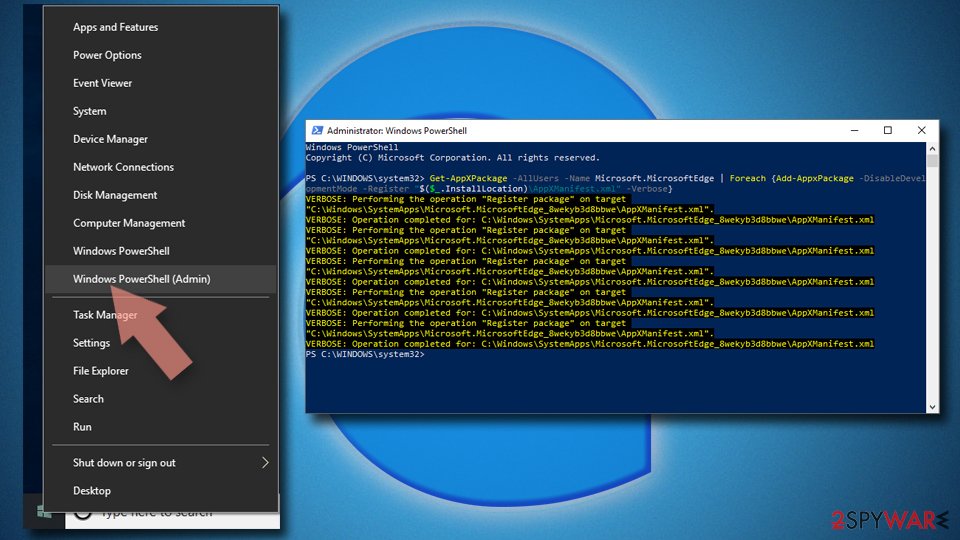
Instructions for Chromium-based Edge
Delete extensions from MS Edge (Chromium):
- Open Edge and click select Settings > Extensions.
- Delete unwanted extensions by clicking Remove.
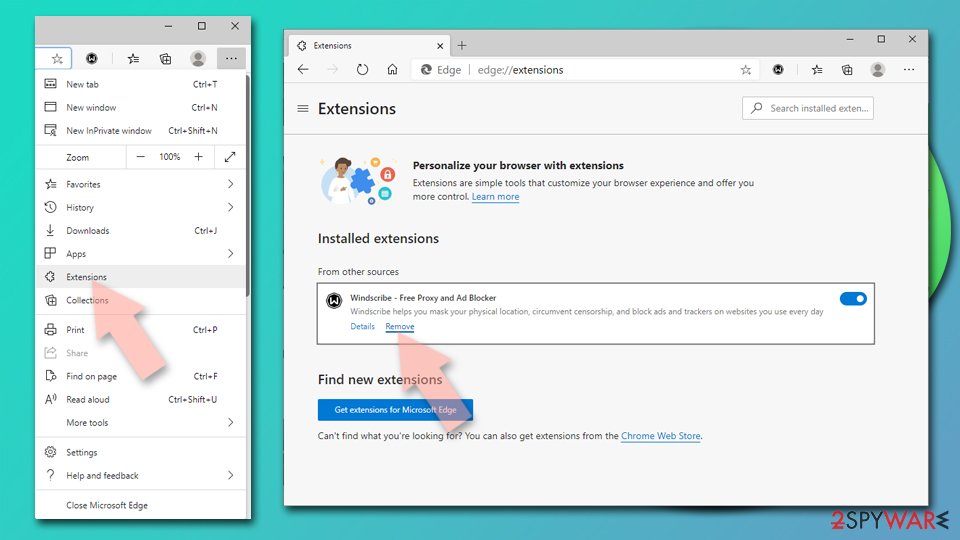
Clear cache and site data:
- Click on Menu and go to Settings.
- Select Privacy, search and services.
- Under Clear browsing data, pick Choose what to clear.
- Under Time range, pick All time.
- Select Clear now.
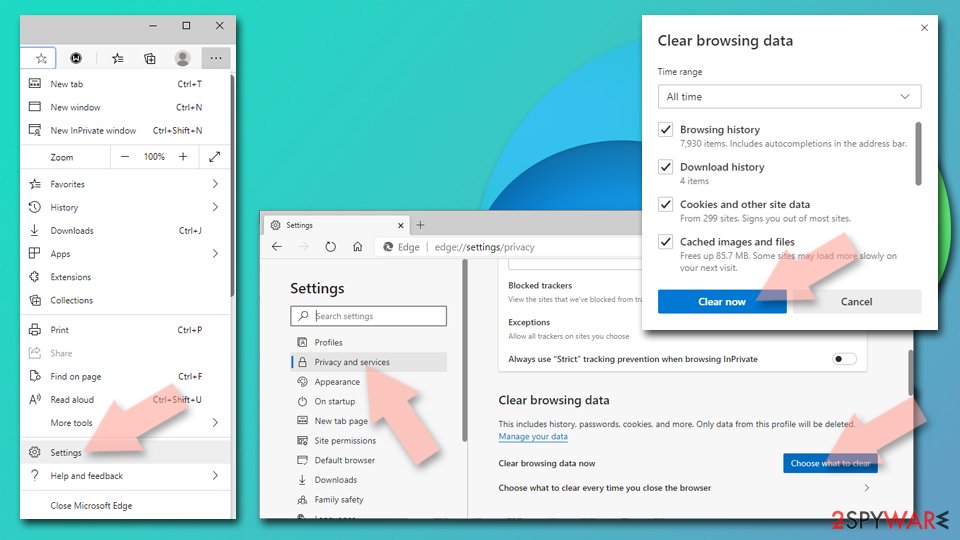
Reset Chromium-based MS Edge:
- Click on Menu and select Settings.
- On the left side, pick Reset settings.
- Select Restore settings to their default values.
- Confirm with Reset.
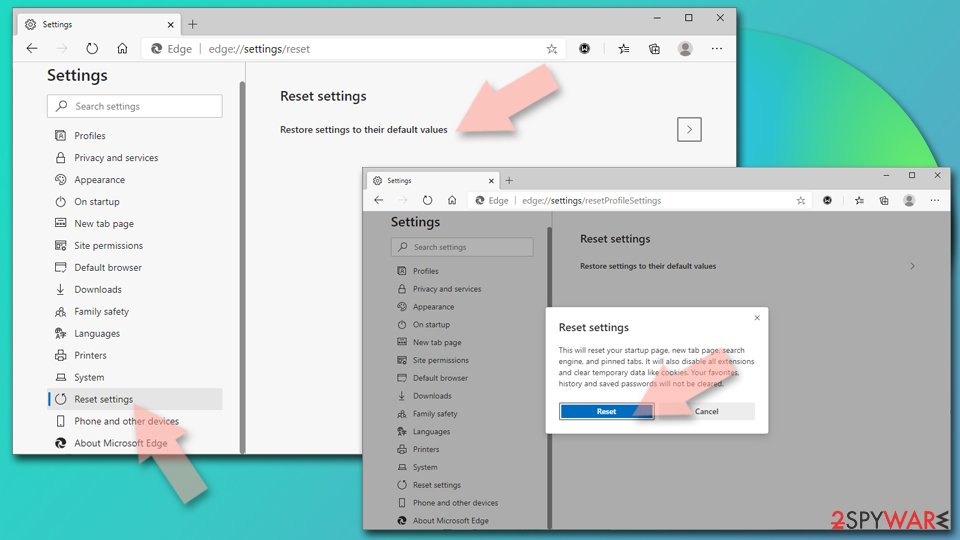
Remove from Mozilla Firefox (FF)
Remove dangerous extensions:
- Open Mozilla Firefox browser and click on the Menu (three horizontal lines at the top-right of the window).
- Select Add-ons.
- In here, select unwanted plugin and click Remove.
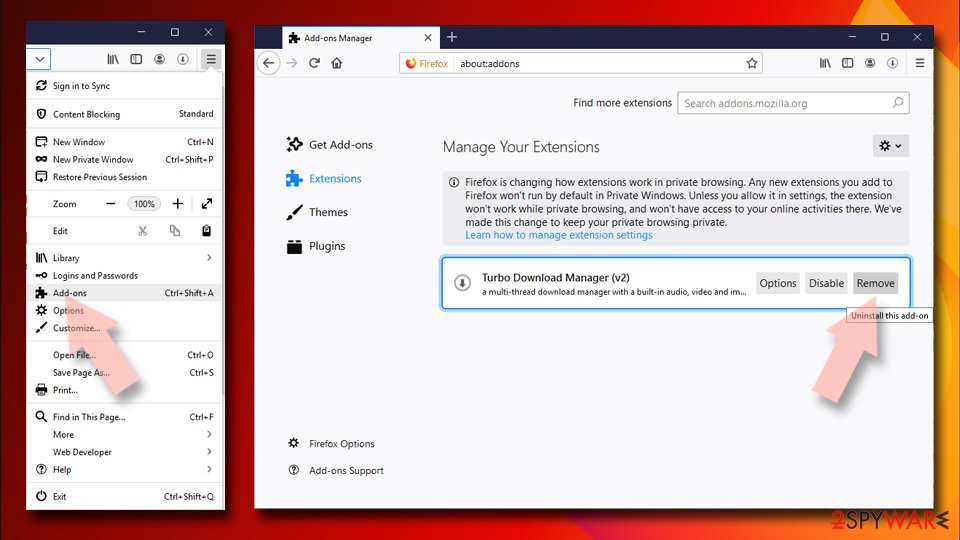
Reset the homepage:
- Click three horizontal lines at the top right corner to open the menu.
- Choose Options.
- Under Home options, enter your preferred site that will open every time you newly open the Mozilla Firefox.
Clear cookies and site data:
- Click Menu and pick Settings.
- Go to Privacy & Security section.
- Scroll down to locate Cookies and Site Data.
- Click on Clear Data…
- Select Cookies and Site Data, as well as Cached Web Content and press Clear.
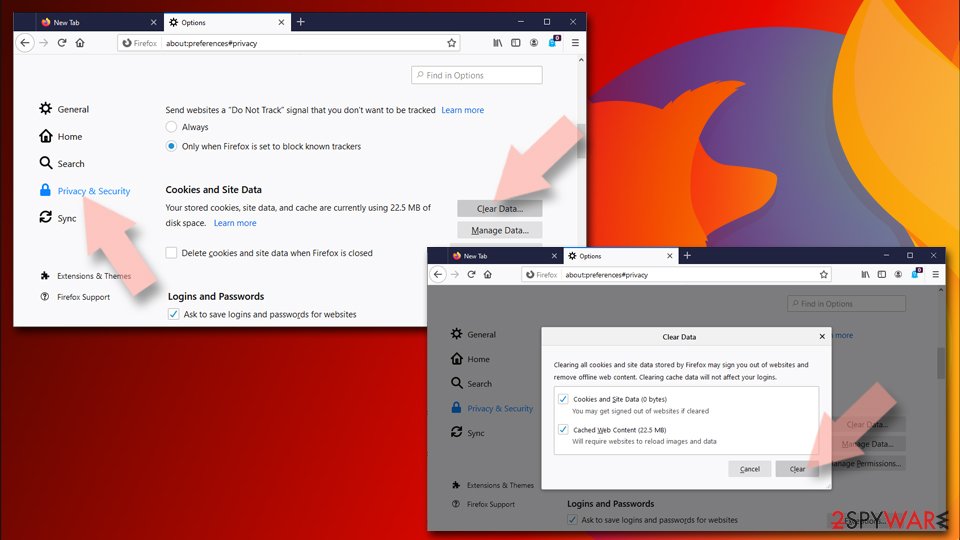
Reset Mozilla Firefox
If clearing the browser as explained above did not help, reset Mozilla Firefox:
- Open Mozilla Firefox browser and click the Menu.
- Go to Help and then choose Troubleshooting Information.
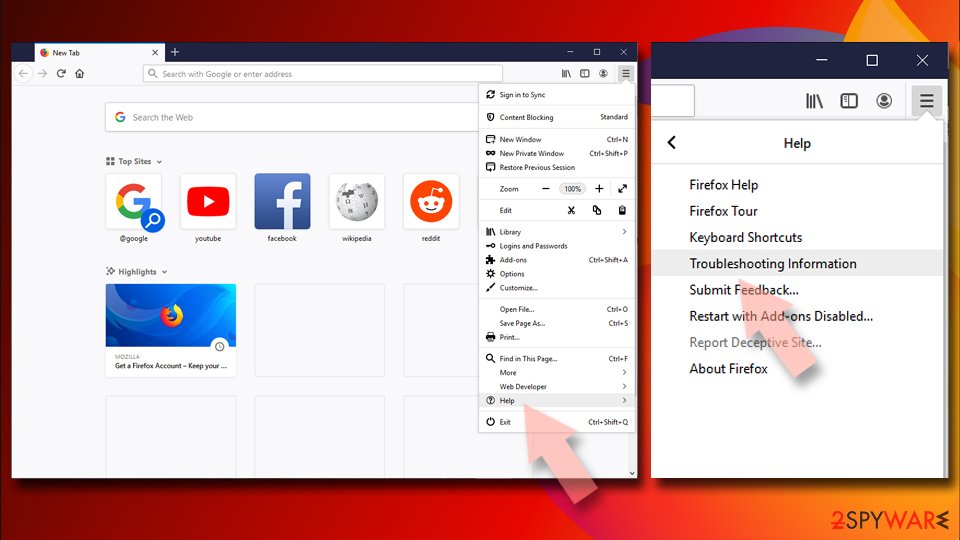
- Under Give Firefox a tune up section, click on Refresh Firefox…
- Once the pop-up shows up, confirm the action by pressing on Refresh Firefox.
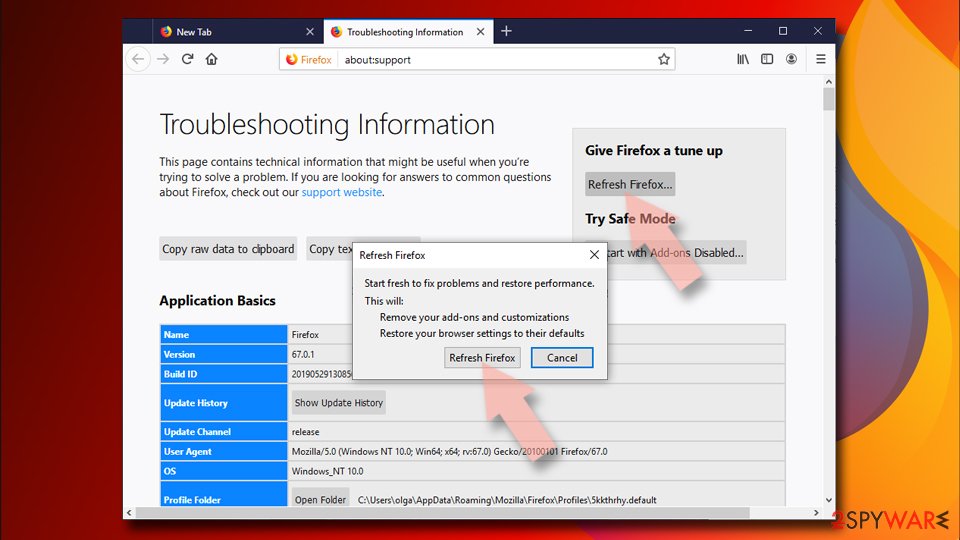
Remove from Google Chrome
If you can not delete TiktokSearches from your web browser, you should reset Google Chrome:
Delete malicious extensions from Google Chrome:
- Open Google Chrome, click on the Menu (three vertical dots at the top-right corner) and select More tools > Extensions.
- In the newly opened window, you will see all the installed extensions. Uninstall all the suspicious plugins that might be related to the unwanted program by clicking Remove.
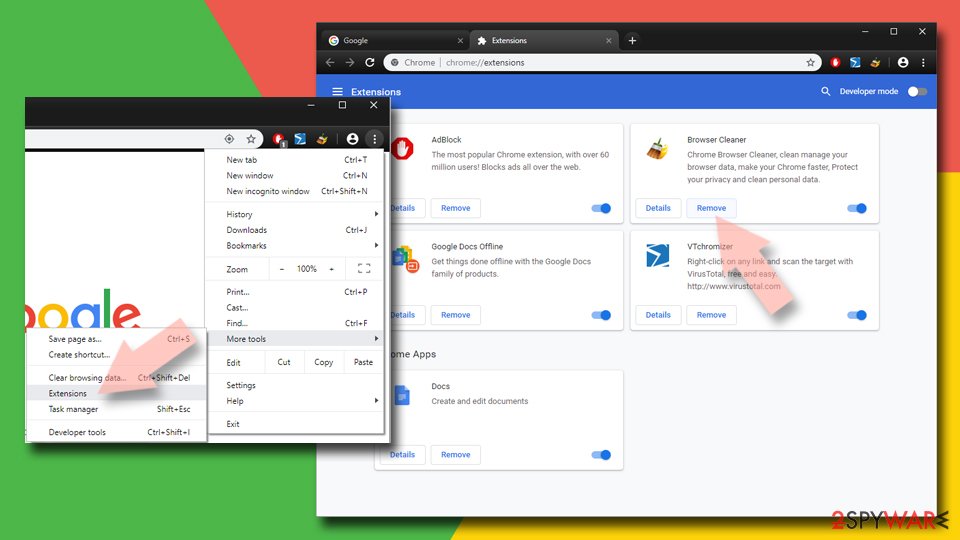
Clear cache and web data from Chrome:
- Click on Menu and pick Settings.
- Under Privacy and security, select Clear browsing data.
- Select Browsing history, Cookies and other site data, as well as Cached images and files.
- Click Clear data.
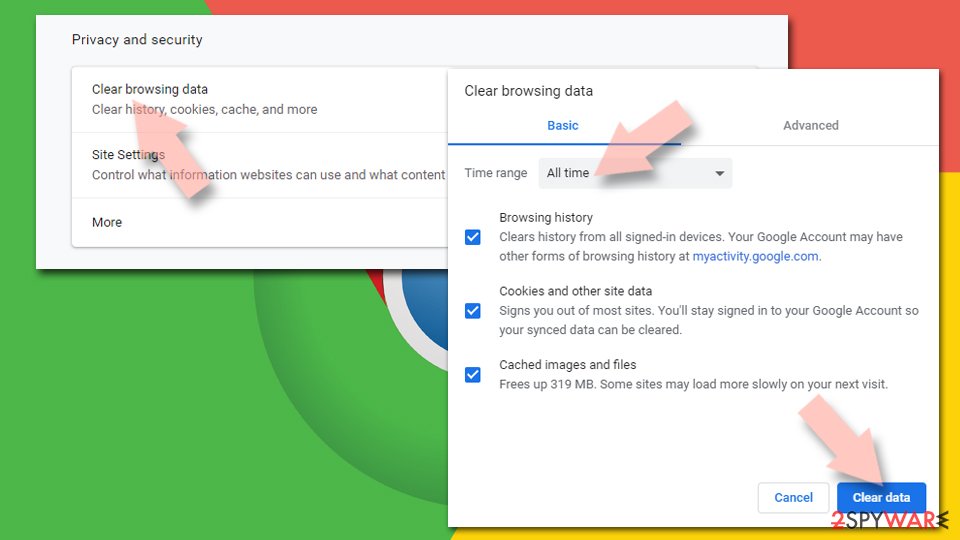
Change your homepage:
- Click menu and choose Settings.
- Look for a suspicious site in the On startup section.
- Click on Open a specific or set of pages and click on three dots to find the Remove option.
Reset Google Chrome:
If the previous methods did not help you, reset Google Chrome to eliminate all the unwanted components:
- Click on Menu and select Settings.
- In the Settings, scroll down and click Advanced.
- Scroll down and locate Reset and clean up section.
- Now click Restore settings to their original defaults.
- Confirm with Reset settings.
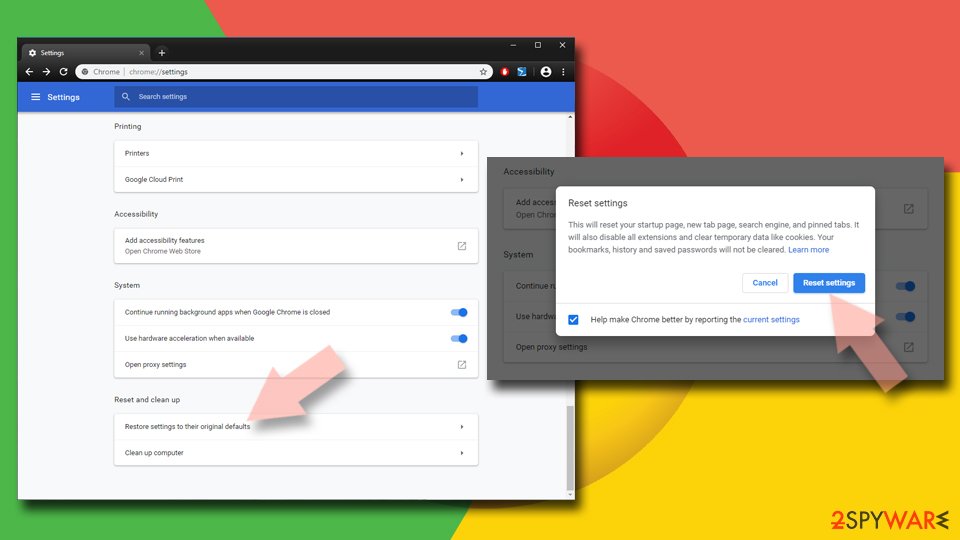
Delete from Safari
Remove unwanted extensions from Safari:
- Click Safari > Preferences…
- In the new window, pick Extensions.
- Select the unwanted extension and select Uninstall.
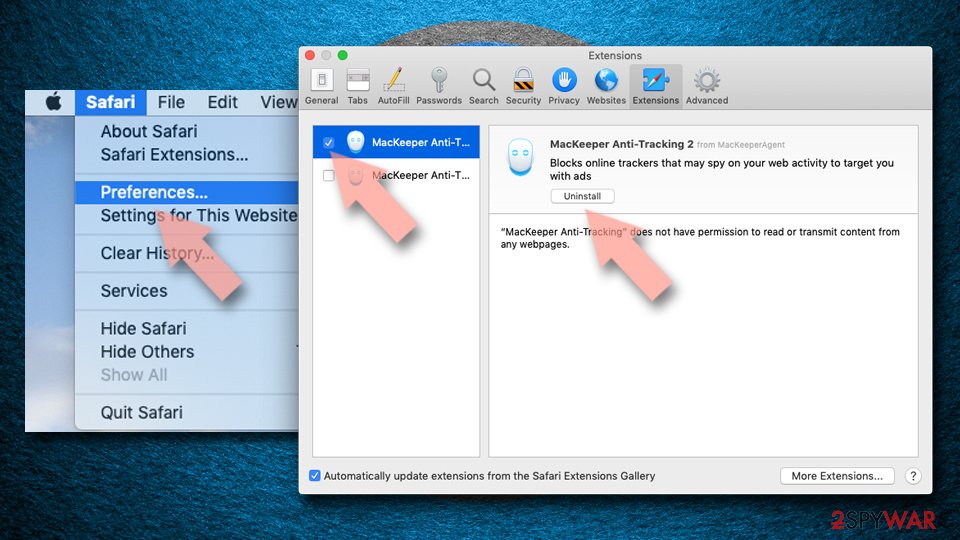
Clear cookies and other website data from Safari:
- Click Safari > Clear History…
- From the drop-down menu under Clear, pick all history.
- Confirm with Clear History.
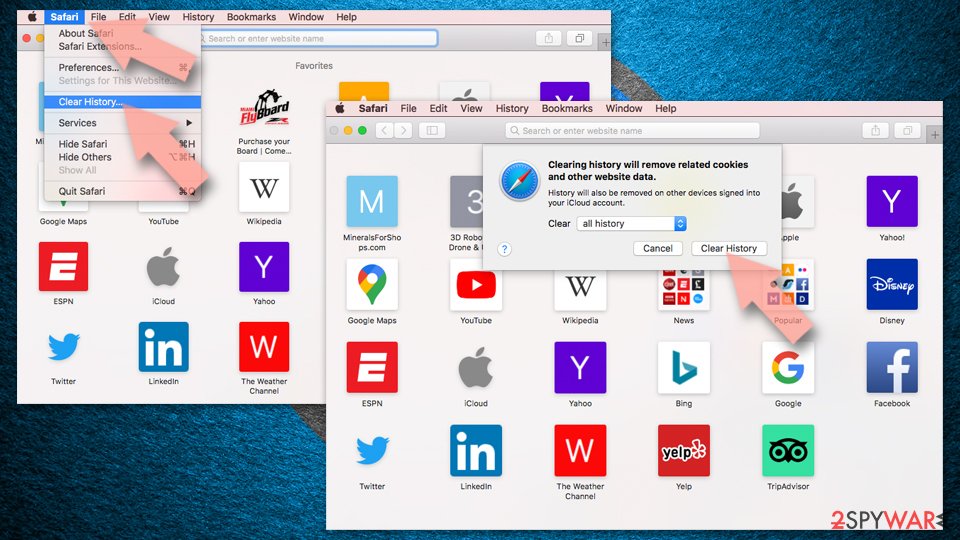
Reset Safari if the above-mentioned steps did not help you:
- Click Safari > Preferences…
- Go to Advanced tab.
- Tick the Show Develop menu in menu bar.
- From the menu bar, click Develop, and then select Empty Caches.
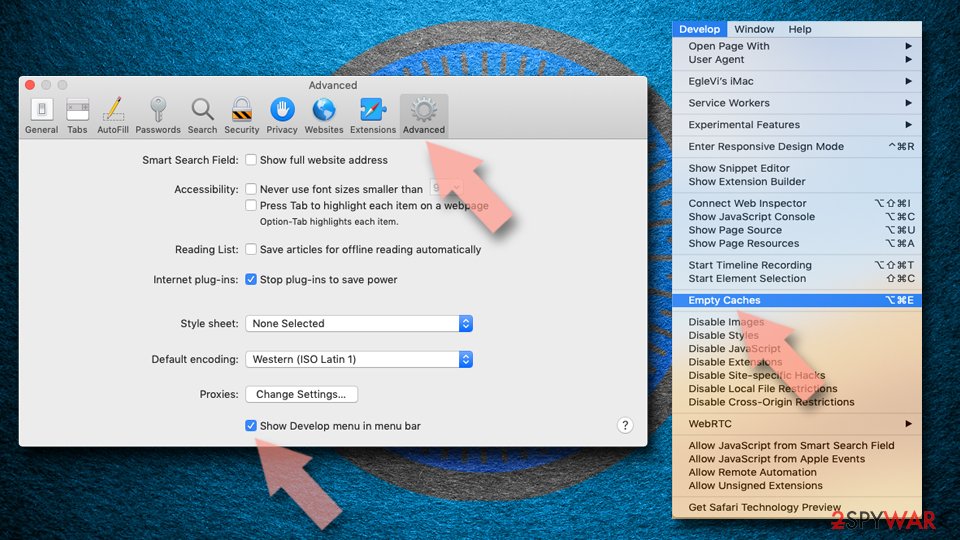
After uninstalling this potentially unwanted program (PUP) and fixing each of your web browsers, we recommend you to scan your PC system with a reputable anti-spyware. This will help you to get rid of TiktokSearches registry traces and will also identify related parasites or possible malware infections on your computer. For that you can use our top-rated malware remover: FortectIntego, SpyHunter 5Combo Cleaner or Malwarebytes.
How to prevent from getting browser hijacker
Stream videos without limitations, no matter where you are
There are multiple parties that could find out almost anything about you by checking your online activity. While this is highly unlikely, advertisers and tech companies are constantly tracking you online. The first step to privacy should be a secure browser that focuses on tracker reduction to a minimum.
Even if you employ a secure browser, you will not be able to access websites that are restricted due to local government laws or other reasons. In other words, you may not be able to stream Disney+ or US-based Netflix in some countries. To bypass these restrictions, you can employ a powerful Private Internet Access VPN, which provides dedicated servers for torrenting and streaming, not slowing you down in the process.
Data backups are important – recover your lost files
Ransomware is one of the biggest threats to personal data. Once it is executed on a machine, it launches a sophisticated encryption algorithm that locks all your files, although it does not destroy them. The most common misconception is that anti-malware software can return files to their previous states. This is not true, however, and data remains locked after the malicious payload is deleted.
While regular data backups are the only secure method to recover your files after a ransomware attack, tools such as Data Recovery Pro can also be effective and restore at least some of your lost data.
- ^ Chris Hoffman. PUPs Explained: What is a “Potentially Unwanted Program”?. How-To Geek. Site that explains technology.
- ^ Kim Lyons. TikTok hit with complaint from child privacy advocates who say it’s still flouting the law. The Verge. Technology news website.
- ^ Udenvirus. Udenvirus. Cybersecurity advice and malware news.
